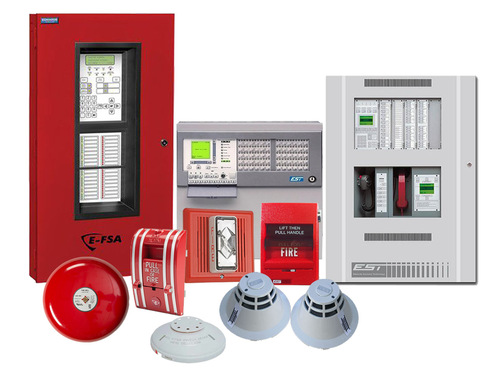Product Description
A Fire Alarm Control Panel (FACP), also known as a Fire Alarm Control Unit (FACU), is a critical component of a fire alarm system. It is a centralized unit that monitors and controls various devices within a building or facility to detect and respond to fires and other emergency situations.
Here are some key aspects of a Fire Alarm Control Panel:
1. Detection and Notification: The primary function of the FACP is to detect the presence of a fire or other emergencies through various input devices, such as smoke detectors, heat detectors, manual pull stations, and water flow switches. When a potential threat is detected, the FACP activates alarms, which can include horns, strobe lights, and sometimes voice evacuation systems.
2. Zone Control: Modern FACP systems are divided into zones. Each zone typically represents a specific area or section of a building. If a sensor within a particular zone triggers an alarm, the FACP can identify the affected zone, helping emergency responders pinpoint the location of the emergency.
3. Monitoring: The FACP continuously monitors the status of all connected devices. It checks for faults, such as device malfunctions or wiring issues, and reports these problems to the central monitoring station or building management system.
4. User Interface: Fire Alarm Control Panels have user interfaces that allow authorized personnel to interact with the system. This interface may include an alphanumeric keypad or a touchscreen display. Users can acknowledge alarms, silence alarms temporarily, and perform other functions through this interface.
5. Relays and Outputs: FACP systems often have output relays that can be used to control various building functions in response to a fire or other emergency. For example, they can release electromagnetic door locks, shut down HVAC systems to prevent smoke spread, and activate fire suppression systems like sprinklers.
6. Battery Backup: To ensure continuous operation in case of a power outage, fire alarm control panels are typically equipped with battery backup systems that provide power to the panel and connected devices.
7. Communication: Some modern FACP systems are capable of communicating with remote monitoring services or emergency responders through phone lines, internet connections, or cellular networks. This allows for a quicker response to emergencies.
8. Programming and Configuration: The FACP can be programmed and configured to meet the specific needs and requirements of a building. This includes setting alarm thresholds, establishing response protocols, and conducting regular testing and maintenance.
9. Compliance: Fire Alarm Control Panels and the entire fire alarm system are subject to local building codes and regulations. They must be installed, maintained, and tested in compliance with these codes to ensure the safety of occupants.
FAQ:
Q. What is a Fire Alarm Control Panel (FACP)?
Ans: A Fire Alarm Control Panel is a central component of a fire alarm system. It monitors and controls various devices such as smoke detectors, heat detectors, and alarms to detect and respond to fires and other emergencies.
Q. Why is an FACP important?
Ans: An FACP is crucial for the early detection of fires, which can save lives and prevent property damage. It provides a central point of control and monitoring for the entire fire alarm system.
Q. What devices are typically connected to an FACP?
Ans: Devices connected to an FACP include smoke detectors, heat detectors, manual pull stations, sprinkler systems, fire alarms, strobe lights, and more.
Q. How does an FACP detect fires?
Ans: It detects fires through sensors like smoke detectors and heat detectors that respond to changes in air quality or temperature, signaling an alarm when predefined thresholds are exceeded.
Q. What is the purpose of zoning in an FACP?
Ans: Zoning allows the FACP to identify the specific location of an alarm or fault within a building, helping emergency responders respond quickly to the affected area.
Q. Can an FACP be integrated with other building systems?
Ans: Yes, many modern FACP systems can be integrated with building management systems, security systems, and access control systems to enhance overall safety and security.
Q. What should I do if the FACP activates an alarm?
Ans: If the FACP activates an alarm, follow your building's evacuation procedures immediately. Do not ignore the alarm, and always treat it as a potential emergency.
Q. How often should fire alarm systems be tested and inspected?
Ans: Fire alarm systems should be regularly tested and inspected as per local building codes and regulations. This typically includes monthly and annual testing, along with routine maintenance.
Q. Are there regulations governing the installation and maintenance of FACPs?
Ans: Yes, regulations and building codes vary by location, but most jurisdictions have strict requirements for the installation, testing, and maintenance of fire alarm systems, including FACPs.
Q. Do FACPs have battery backup systems?
Ans: Yes, FACPs typically have battery backup systems to ensure they continue to function in the event of a power outage.
Q. Can FACPs communicate with emergency services?
Ans: Some FACPs can communicate with remote monitoring services or emergency responders through phone lines, internet connections, or cellular networks to expedite emergency response.
Q. Can FACPs be remotely monitored?
Ans: Yes, many modern FACPs support remote monitoring, allowing building management or monitoring services to receive real-time information about the status of the fire alarm system.
Q. Can FACPs be customized for specific building needs?
Ans: Yes, FACPs can be programmed and configured to meet the specific requirements and needs of a building, including alarm thresholds, notification protocols, and system integration.
